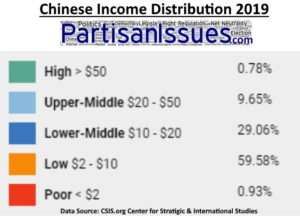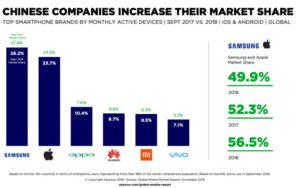 When China began the ‘free-marketization’ of its economy in the 1980’s it was clear that China was going to be an economic powerhouse. They had an excellent blue print to follow in capitalist British Hong Kong and a singular drive to raise its citizens from the poverty of its communist past.
When China began the ‘free-marketization’ of its economy in the 1980’s it was clear that China was going to be an economic powerhouse. They had an excellent blue print to follow in capitalist British Hong Kong and a singular drive to raise its citizens from the poverty of its communist past.
However, few had predicted back then that China would look so completely inward for growth as they are today. It is clear that while foreign markets like the United States, Europe and Canada are important to China, the the numbers prove that they really don’t need all of them anymore.
 In its very public (though not well publicized in the West) plan “Made In China 2025“, the Chinese Communist Party (CCP) a declared its intention to in-source as much high value product as possible. Like Russia in the 1950’s Cold War, Commodore Computers in the 1970’s Calculator Wars and Boeing in 2018, large entities have learned that being dependent on external suppliers, especially ones in other countries makes them particularly vulnerable. They will work to minimize that risk. China is now a very large entity and still has nearly a billion low income citizens to raise up and expand into. Put simply China has its own global market within it boarders.
In its very public (though not well publicized in the West) plan “Made In China 2025“, the Chinese Communist Party (CCP) a declared its intention to in-source as much high value product as possible. Like Russia in the 1950’s Cold War, Commodore Computers in the 1970’s Calculator Wars and Boeing in 2018, large entities have learned that being dependent on external suppliers, especially ones in other countries makes them particularly vulnerable. They will work to minimize that risk. China is now a very large entity and still has nearly a billion low income citizens to raise up and expand into. Put simply China has its own global market within it boarders.
Click the long graphic on the right to see where China falls in income distribution compared to all other countries.
The notion that China wants to produce its own electronic components (CPU’s, cellular modems…) is well known. Further, it is inevitable that China will eventually produce its own mobile operating system to compete with Apple’s iOS and Google’s Android. However, mobile operating systems are much more than just a set of sub-systems to run cell phone calls and process text messages these days. In the last two decades awesome mobile operating systems have failed because they don’t have an ecosystem around them. Specifically an ‘apps store’ loaded with hundreds of thousands ready made, cheap, quality programs that can be installed with just a click.
Remember BlackBerry OS, WebOS, Microsoft CE? If you have anything more than a passing knowledge of those, you are likely over the age of 40 and involved in the tech industry. What killed those OS’s was a lack of applications and the reason developers did not build apps for those operating systems was because of scale. They just can’t justify putting in hundreds of thousands of dollars into new apps for an operating system used by a tiny fraction of users. In other words, they just could not get big enough, fast enough.
How is China Different?
 China is different because unlike other successful countries, China is a dictatorship. All notable companies from China are beholden to the Chinese Communist Party (CCP) and will do what they are told. China is also different because of its massive internal population/market of about 1.4 Billion people.
China is different because unlike other successful countries, China is a dictatorship. All notable companies from China are beholden to the Chinese Communist Party (CCP) and will do what they are told. China is also different because of its massive internal population/market of about 1.4 Billion people.
When China fears that an industry which is central to peace, security and good jobs is at risk, they will act. But unlike others, the decision to use a particular technology or vendor is not be limited to individual corporate decisions.
Click on the graphic to the right to see who really counts in the world of cell phone manufacturers. In a word, China. Chinese manufacturers account for greater than 40% of the worlds cell phones today and is expanding rapidly.
Companies like Oppo, Huawei, Xiaomi and Vivo will all act as one, when they are told to by their CCP masters.
How did US President Trump Kill Android OS?
Until a year ago China was happy using Western (US, Canada, EU…) sourced key cell phone components but especially the Google Android operating system. The US-China trade war has shown China just how vulnerable they are to the whims of foreigner vendors and governments. They redoubled their already well funded efforts to produce replace those Western vendors with Chinese hardware. The one thing Chinese companies were not focusing on was the Operating System software.
As discussed a successful mobile operating system requires an entire ecosystem around it and that was going to be a project for the future. Until now, China was ‘picking its battles’ and working the low hanging fruit bite by bite. Hardware like CPU’s, modems, screens and other components were their focus.
In March 2019, it was no surprise to tech insiders and those that follow China to read the South China Morning Post reporting that Huawei was developing its own mobile operating system.
Yesterday’s announcement by US President Donald Trump to add 10% tariffs to virtually all products imported from China combined with his decision earlier in 2019 to block the sale of US sourced components to Chinese manufacturers like Huawei, Oppo and Vivo has served to galvanize the Chinese government resolve to replace Western vendors.
Neither the Chinese Government nor Chinese cell manufacturers will publicly state that the one thing they cannot easily replace is the Android Operating System, because you don’t tell your opponent where you are the weakest. Huawei Founder and CEO Ren Zhengfei has politely answered reporters questions about replacing Android in recent weeks by downplaying the effort his company is applying and saying it is a bad idea:
…Arbitrarily dividing technology into two different camps will only harm the interests of the world. I believe the ideals of the technological community and scientists, as well as the wisdom of political figures coming together, will determine the future of humanity. Personally, I strongly support unified global standards. SOURCE
Executives publicly deny they have a Android replacement program, even though it is well documented:
…Details of a Huawei mobile OS first emerged in May (2019) when Richard Yu, the CEO of the consumer business, told an audience in China that a new mobile OS “would be available in the fall of this year and at the latest next spring,” one that would be “compatible with all Android applications and web applications and improve running performance by more than 60%.” SOURCE
If a full blown ban on Android does hit Chinese cell phone makers, they have gone so far as to consider using the Russian developed Aurora Mobile Operating System to stay in business. They know that Western citizens will not accept substandard and non-standard product so the Chinese are putting vast resources into fast tracking a real replacement for Android.
It is quite clear that Chinese cell manufacturers and Chinese Government now see little choice but to tolerate the considerable pain of transitioning to their own OS.
All of this is thanks to the Trump decision to highlight the single-point-of-failure in the Chinese cell manufacturing process.
To be clear, it is not that US President Trump‘s trade decisions are the only factor in moving away Android, but he moved up the date from about 2030 to 2023 when he gave the Chinese no options.



0 Comments